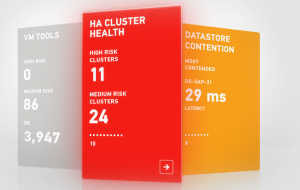Disclaimer: I’m a technical advisor for CloudPhysics.
I’m very happy to see CloudPhysics coming out of stealth mode this week and making their beta product available to the public. In a nutshell CloudPhysics is bringing Big Data analytics to the IT environment and it will provide you with tools to analyze your datacenter. How does it acquire this dataset and what benefit do you get from it?
The Observer Appliance
To gather all that data, an Observer Appliance needs to run in the virtual infrastructure. And in order to get a valuable dataset that is used for analytics and simulations the Observer needs to be active in as many as virtual infrastructures as possible. Running an appliance that sends operational data to a third party like CloudPhysics can be a security concern. Going into detail about how CloudPhysics designed the system to handle privacy, security and data sharing issues is outside the scope of this article. In short, data extracted from the virtual infrastructure are performance statistics and inventory and configuration settings. All environmental details are scrubbed and no log files or content of disk and memory is gathered.
The User Interface
The data acquired by the Observer Appliance is accessible at https://app.cloudphysics.com. Logging in will give you access to your own data. The beta product provides a user interface that allows you to dive into specific focus areas. The UI provides so-called cards that displays key data points and is a launch point to a more detailed view. This view can contain information about the relationship with other features of the vSphere stack. An example of such a card would be Virtual Machine level reservations. Not only does this card provide you information about the present virtual machine level reservations in your environment in a clear and concise manner, it also displays the impact the reservation has on the High Availability slot size and therefor the consolidation ratio of your cluster. All this information combined in a single screen, no need to navigate through multiple screens and correlate particular metrics.

Correlation of metrics
Correlation of particular settings and understanding the impact each setting has on a complex environment, such as a virtual infrastructure, is time consuming and above all very difficult. This correlation of metrics allows you to save time, but it also helps you understand behavior of your environment. Now you might ask how do you know you can trust if these correlations are correct and this is one of the most interesting things about this product. It’s a combination of product expertise and community driven input.
The two pillars of knowledge
The CloudPhysics team comprises of industry heavy hitters. Some of these persons invented core features of the vSphere stack while working for VMware, while others made their mark at other industry leading companies. The second pillar is the community involvement. In this beta program, registered users can suggest ideas for utility cards. Domain experts will verify the community provided cards on technical accuracy.
Near-future developments
One thing I’m very exited about is the upcoming High Availability and DRS simulation tools. Both HA and DRS can be a challenge to configure as some settings impact the virtual infrastructure on multiple levels. The HA and DRS simulation analyzes current settings and provides you a platform where you can predict the effects of a change on your environment.
VMworld Challenge 2012
Now back to the current status. CloudPhysics is running a VMworld Challenge 2012. The contest allows you to describe the problems you are facing, such as “I’m applying different disk shares in my environment but I cannot see the worst case scenario allocation”. The more card you produce, the more points you score. To increase your score, download the Observer Appliance and take your environment for a test drive. The more activity you generate, the more points you accumulate. How will you benefit from this contest, first of all, if you are located in the U.S. you can win some great prices. (Due to U.S legislation, non-U.S. residents are excluded from winning prizes), but by submitting cards you improve the system and the quality of the reporting tool and simulation tool.
Resource Management as a Service
I started of with a disclaimer, I am a technical advisor to CloudPhysics and you can expect to see more articles about the development of CloudPhysics. As I’m able to work with the inventors of DRS and Storage DRS, a lot of my focus is on resource management. Together with the input of the community, the continuous analysis by domain experts you can expect that this might well turn out as Resource Management as a Service.